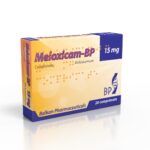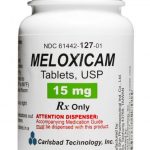How Long Does Meloxicam Stay In Your System?

What is meloxicam?
Meloxicam is a medication used to relieve pain, tenderness, swelling, and stiffness caused by osteoarthritis (arthritis caused by a breakdown of the lining of the joints) and rheumatoid arthritis (arthritis caused by swelling of the lining of the joints). Meloxicam is also used to relieve the pain, tenderness, swelling, and stiffness caused by juvenile rheumatoid arthritis (a type of arthritis that affects children) in children 2 years of age and older.
How it works
Meloxicam belongs to a class of drugs called nonsteroidal anti-inflammatory drugs (NSAIDs). NSAIDs help reduce pain, inflammation, and fever. It isn’t known how this medication works to decrease pain. It may help reduce swelling by lowering levels of prostaglandin, a hormone-like substance that usually causes inflammation.
How should meloxicam be used?
Meloxicam comes as a tablet and suspension (liquid) to take by mouth. It is usually taken once a day with or without food. Take meloxicam at the same time every day.
Typical dosing for meloxicam (Mobic)
Tablets
Rheumatoid arthritis and osteoarthritis: Take 7.5 mg to 15 mg by mouth once a day. Do not take more than 15 mg a day.
Juvenile rheumatoid arthritis: Take 7.5 mg by mouth once a day. Do not take more than 7.5 mg a day.
Capsules
Rheumatoid arthritis and osteoarthritis: Take 5 mg to 10 mg by mouth once a day. Do not take more than 10 mg a day.
Follow the directions on your prescription label carefully, and ask your doctor or pharmacist to explain any part you do not understand. Take meloxicam exactly as directed. Do not take more or less of it or take it more often than prescribed by your doctor.
Shake the suspension well before each use to mix the medication evenly. The maximum recommended daily oral dose of meloxicam is 15 mg. Meloxicam may be taken without regard to the timing of meals.
How long does meloxicam stay in your system?
There are several factors that come into play when estimating how long Meloxicam will stay in your system because every patient has physiology unique to them. Here are some major factors you should consider when trying to understand how long Meloxicam will stay in your body:
• Age: Typically, the younger you are, the more efficient your body functions are. The more efficient your body functions, the faster Meloxicam will be removed from your system.
• Amount: The higher the dose of Meloxicam you have been taking, the longer Meloxicam will take to be removed from your system.
• Genetics: Genes predispose people to different metabolic functions, which is a key factor in how your body processes medications like Meloxicam. For this reason, your genetic makeup comes into play when estimating how long Meloxicam will remain in your system.
• Kidney and liver functions: The liver and kidneys eliminate everything you ingest, and Meloxicam is no exception. If your liver or kidneys are damaged, it will most likely take longer for your body to remove the Meloxicam from your system.
• Metabolism: Your metabolism determines how quickly you process foods, liquids, and drugs such as Meloxicam. If your metabolism is slow, it will take longer for your body to process and eliminate Meloxicam from its system than someone with a fast metabolism.
• Usage frequency: The longer you have been taking Meloxicam, the longer it will remain in your system. For example, it will take longer for someone who has taken Meloxicam for several years to remove Meloxicam from the body than someone who has only been taking Meloxicam for a few months.
According to studies, the elimination half-life of meloxicam is approximately 20 hours. The half-life of a drug is the time it takes for the amount of a drug’s active substance in your body to reduce by half.
About 94 to 97% of a drug will have been eliminated after 4 to 5 half-lives. Thus, it follows that after 4 to 5 half-lives, the plasma concentrations of a given drug will be below a clinically relevant concentration and thus will be considered eliminated. This means that meloxicam will clear out of a person’s system within 5 days (approximately 100 hours) after the last dose but the elimination may vary based on multiple factors already stated above.
How long does meloxicam provide pain relief?
Meloxicam starts working within 30 minutes, but peaks in efficacy at four hours when taken by mouth. It provides relief for up to 24 hours because it is a long-acting drug. Peak concentrations are reached within 2 hours (capsule) and 4 to 5 hours (tablets). Meloxicam appears to be recycled in the liver so another peak is reached in 8 hours (capsule) or 12-14 hours (tablet) after the initial dose.
What are the possible side effects of meloxicam?
Meloxicam may cause side effects. Tell your doctor if any of these symptoms are severe or do not go away:
• constipation
• diarrhea
• gas
• sore throat
Some side effects can be serious. If you experience any of the following symptoms, call your doctor immediately. Do not take any more meloxicam until you speak to your doctor:
• back pain
• blisters
• cloudy, discolored, or bloody urine
• difficult or painful urination
• difficulty breathing or swallowing
• fast heartbeat
• fever
• flu-like symptoms
• hives
• hoarseness
• itching
• lack of energy
• nausea
• pain in the right upper part of the stomach
• pale skin
• rash
• shortness of breath or difficulty breathing
• skin blisters or peeling
• swelling in the abdomen, ankles, feet, or legs
• swelling of the eyes, face, tongue, lips, or throat
• unexplained weight gain,
• yellowing of the skin or eyes
Meloxicam may cause other side effects. Call your doctor if you have any unusual problems while taking this medication.
If you experience a serious side effect, you or your doctor may send a report to the Food and Drug Administration’s (FDA) MedWatch Adverse Event Reporting program online (http://www.fda.gov/Safety/MedWatch) or by phone (1-800-332-1088).





